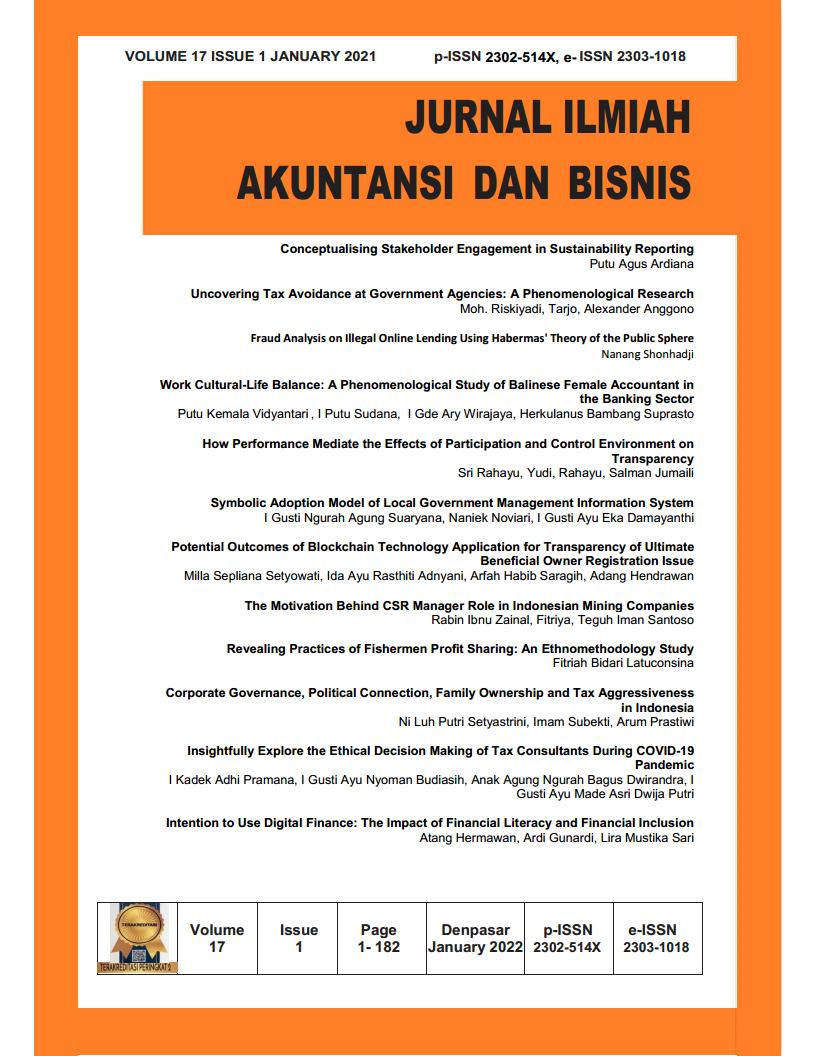Fraud Analysis on Illegal Online Lending Using Habermas' Theory of the Public Sphere
Abstract
This study aims to investigate and expose the fraudulent practices conducted by P2P lending service providers in illegal online loan schemes, through the lens of Habermas' critical theory. The research was conducted in areas affected by illegal online lending practices, with informants consisting of users and victims of fraud from Surabaya, Sidoarjo, and Pasuruan, East Java. This qualitative study adopts a Radical Humanist Paradigm approach. The findings indicate that Habermas' theory of the public sphere provides a useful framework for understanding the mechanisms of fraud employed by illegal financial technology lenders. The study underscores the need for clearer regulations governing P2P lending transactions conducted via online platforms, as well as stricter sanctions for perpetrators of illegal online loan fraud, as part of raising public awareness and ensuring consumer protection.
Keywords: fraud, online loans, Habermas
Downloads
References
Cheng, H., & Guo, R. (2020). Risk Preference of the Investors and the Risk of Peer-to-Peer Lending Platform Emerging Markets Finance & Trade, 56(7), 1520-1531. doi:10.1080/1540496X.2019.1574223
Davis, K., Maddock, R., & Foo, M. (2017). Catching up with indonesia’s fintech industry. Law and Financial Markets Review, 11(1), 33–40. doi:https://doi.org/10.1080/17521440.2017.1336398
Duma, F., & Gligor, R. (2018). Study regarding Romanian students’ perception and behaviour concerning the fintech area with a focus on cryptocurrencies and online payments Online Journal Modelling the New Europe, 27, 86-106. doi:https://doi.org/10.24193/OJMNE.2018.27.04
Ferrari, R. (2016). FinTech Impact on Retail Banking - From a Universal Banking Model to Banking Verticalization The FinTech Book (pp. 248–252). USA: Entrepreneurs and Visionaries.
Gomber, P., Koch, J.-A., & Siering, M. (2017). Digital Finance and FinTech: current research and future research directions Journal of Business Economics, 87(5), 537–580. doi:https://doi.org/10.1007/s11573-017-0852-x
Goode, L. (2005). Jurgen Habermas: Democracy and the Public Sphere (Modern European Thinkers). Northampton: Pluto Press.
Habermas, J. (1962). The Structural Transfornation of the Public Sphere: An Inquiry into a Category of a Bourgeois Cambridge, MA: MIT: Society Press.
Habermas, J. (2010). Ruang Publik, Sebuah Kajian Tentang Kategori Masyarakat Borjuis (terjemahan) Bantul: Kreasi Wacana.
Huda, S., Sarno, R., & Ahmad, T. (2016). Increasing accuracy of Process-based Fraud Using Behavior Models. International Journal of Software Engineering and Its Applications, 10(5), 175-188. doi:http://dx.doi.org/10.14257/ijseia.2016.10.5.16
Jaduk, G. P. (2017). Rekonstruksi Pemikiran Habermas Di Era Digital. Jurnal Komunikasi Dan Kajian Media, 1(1), 1-14. doi:10.31002/jkkm.v1i1.381
Kiarie, R. K. (2021). Ethics in Mobile Banking: A Case Study of Kenya's Mobile Money Platform Research
Anthology on Concepts, Applications and Challenges of Fintech. USA: IGI Global Publisher.
Lee, I., & Shin, Y. J. (2018). Fintech: Ecosystem, business models, investment decisions, and challenges. Business Horizons, 61(1), 35-46. doi:https://doi.org/10.1016/j.bushor.2017.09.003
Leong, C., Tan, B., Xiao, X., Tan, F. T. C., & Sun, Y. (2017). Nurturing a FinTech ecosystem: The case of a youth microloan startup in China International Journal of Information Management, 37(2), 92–97. doi: 10.1016/j.ijinfomgt.2016.11.006, 37(2), 92-97. doi:10.1016/j.ijinfomgt.2016.11.006
Manan, Y. M. (2019). Sistem Integrasi Proteksi & Manajemen Resiko Platform Fintech peer to peer (P2P) Lending dan Payment Gateway untuk Meningkatkan Akselerasi Pertumbuhan UMKM 3.0. Ihtifaz: Journal of Islamic Economics, Finance, and Banking, 2(1), 73-87. doi:10.12928/ijiefb.v2i1.847
Midgley, D. (2012). Beyond Habermas: Democracy, Knowledge, and the Public Sphere. London: British Library Montag.
Omarini, E. (2018). Peer-to-Peer lending: Business Model Analysis and the Platform
Dilemma. International Journal of Finance, Economics and Trade, 2(3), 31-41. doi:http://dx.doi.org/10.19070/2643-038X-180005
Ozcelik, H. (2020). An Analysis of Fraudulent Financial Reporting Using the Fraud Diamond Theory Perspective: An Empirical Study on the Manufacturing Sector Companies Listed on the Borsa Istanbul. Contemporary Issues In Audit Management and Forensic Accounting, 102, 131-153. doi:https://doi.org/10.1108/s1569-375920200000102012
Ozili., P. K. (2018). Impact of digital finance on financial inclusion and stability. Borsa Istanbul Review, 18(4), 329-340. doi:https://doi.org/10.1016/j.bir.2017.12.003
Pollari, I. (2016). The rise of Fintech opportunities and challenges. JASSA: The Journal of The Securities Institute of Australia, 3, 15-21. doi:https://search.informit.org/doi/10.3316/informit.419743387759068
Raden, A. E. W., & Bambang, E. T. (2019). Praktik Finansial Teknologi Ilegal dalam Bentuk Pinjaman online Ditinjau dari Etika Bisnis Jurnal Pembangunan Hukum Indonesia, 1(3), 379-391. doi:https://doi.org/10.14710/jphi.v1i3.379-391
Rengganis, R. M. Y. D., Sari, M. M. R., Budiasih, I. G. A., Wirajaya, I. G. A., & Suprasto, H. B. (2019). The Fraud Diamond: Element In Detecting Financial Statement of Fraud. International Research Journal of Management, IT and Social Sciences, 6(3). doi:https://doi.org/10.21744/irjmis.v6n3.621
Romānova, I., & Kudinska, M. (2016). Banking and Fintech: A Challenge or Opportunity? . Contemporary Studies in Economic and Financial Analysis, 98, 21-35. doi:Doi: 10.1016/j.jeconbus.2018.07.003
Saksonova, S., & Kuzmina-Merlino, I. (2017). Fintech as financial innovation - The possibilities and problems of implementation. European Research Studies Journal, 20(3), 961-973. doi:https://doi.org/10.1021/ja00368a049
Stewart, H., & Jürjens, J. (2018). Data security and consumer trust in FinTech innovation in Germany. Information and Computer Security, 26(1), 109-128. doi:https://doi.org/10.1108/ICS-06-2017-0039
Suseno, A. W., & Yeti, S. (2021). Tanggung Jawab Korporasi Fintech Lending Ilegal dalam Perspektif Perlindungan Konsumen Law Review, XXI(1), 117-144. doi:http://dx.doi.org/10.19166/lr.v0i0.3544
Teten, T. (2021). Pelanggaran Penyelenggara Peer To Peer (P2P) Lending Financial Technology Ilegal Terhadap Debitur Logika: Jurnal Penelitian Universitas Kuningan, 12(1), 85-93. doi:https://doi.org/10.25134/logika.v12i01.4040
Wang, Y., Han, X., Li, Y., & Liu, F. (2021). Efficiency and Effect of Regulatory Policies on the Online Peer-to-peer (P2P) Lending Industry. Emerging Markets Finance & Trade, ahead of print, 1-14. doi:10.1080/1540496x.2021.1882987




















